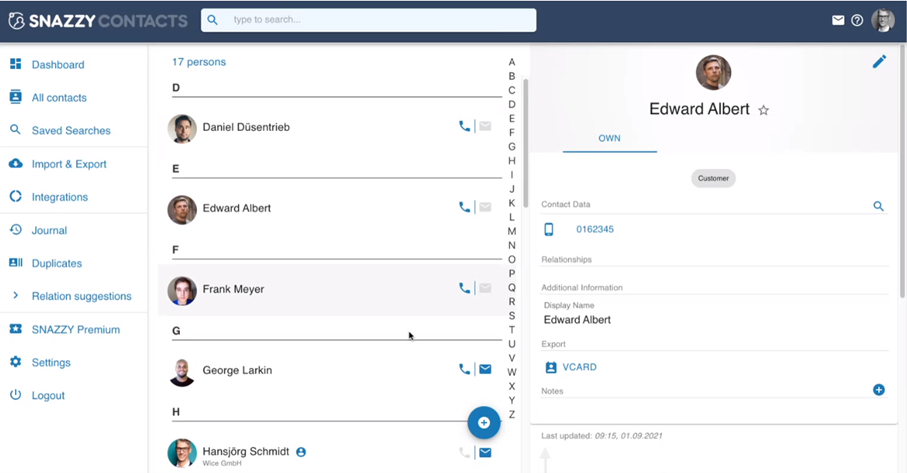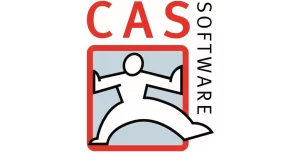Today in focus: Snazzy Contacts
Snazzy Contacts offers a new approach to the challenges of customer data management, especially when this data is distributed and synchronized across many data pots. With Snazzy Contacts, it is very easy to merge all this customer data at a central data point and thus transform it into a flexible “data powerhouse”.
Status quo and problems in customer data management
If a company considers customer data or contact data self-critically, then these usually do not have the consistently high quality that the company needs. Regardless of the size of a company, the customer data is therefore usually neither 100% GDPR compliant nor qualitatively good enough to control sales or service and marketing activities with this.
Therefore, a company can never gain full control over the customer or contact details as long as such problems exist. It remains the feeling of a tightened handbrake.
Why customer data management remains relevant and why the importance can only increase in the future can only be read on CRM-TECH.WORLD here.
Snazzy Contacts is the solution – for both SMEs and large enterprises
What approach does Snazzy Contacts use to solve the problem described above?
Snazzy Contacts pursues the approach of realizing the integration of best-of-breed. With Snazzy Contacts, companies and users get a simple and effective tool at their fingertips. The data must be organized, analyzed and controlled centrally in one place. In this way, the company avoids unnecessary silos.
Only when all customer data is managed centrally and cleanly in one place are it useful to distribute them to all other solutions in the company. Without data integration, an employee might need to be set up as a user to all other applications, logging in to multiple systems, downloading multiple records, deleting all data, and then creating their own unified customer database. A costly and error-prone effort.
How does Snazzy Contacts work?
Snazzy Contacts is a cloud-based system. All existing data sources are merged and kept integrated.
By connecting to the Open Source Framework Open Integration Hub, this is easy.
The Open Integration Hub – OIH for short – can be described as “the data hub” in a company on which Snazzy Contacts is based.
As the number of tools radically increases, the old-fashioned models of data integration are collapsing. The old type of native integration was mostly designed as a paired two-way integration. You connect the tools one by one. But not every API or integration can support every type of data type in both directions, even if the tool can. This leads to a high level of complexity. Due to the OIH, it is no longer necessary to Programming interfaces between different apps or on-premise solutions! By using the OIH, the company programs a single interface to the OIH. The data is available in all other applications via the OIH’s data hub or distribution platform.
Important advantage of the Open Integration Hub (OIH)
A fundamental advantage of the OIH is its simple architecture.
Through this, an experienced programmer needs, based on the previous experiencesIn order to support the work on an interface, a tool was also developed that can “scrape” an API. Based on the results of a scrap, Snazzy provides a prototype for the interface. Simply put, the tool “reads” the API and recognizes the programming standards used and this information is put together. This results in the prototype as a basis for the manufacturer, only about a day to develop a connector. And that, in our opinion, is very fast!
Interaction Open Integration Hub and Snazzy Contacts
What is the Open Integration Hub for?
The OIH is an open source solution and thus provides the open source framework with which the integration of the various tools (in which customer data is available) for managing this customer data takes place.
All applications are connected to the hub via connectors, which ensures data exchange between all of them.
Snazzy Contacts, on the other hand, focuses on the data domain of the contact data – i.e. the contents of the fields of the customer data or address data.
The result:
By integrating via the OIH, data is then consolidated and synchronized in one system, eliminating silos and maintaining the flexibility and independence of the best-of-breed approach.
Snazzy Contacts will then automatically collect the data from the various sources and provide it in a single customer view. With Snazzy Contacts, the company accesses the consolidated or adjusted data
 Image commentary: The image above is intended to illustrate the interaction of the OIH and Snazzy. Since the data model of Snazzy is the data model of the OIH, the functionality of a customer data platform can be implemented via Snazzy.
Image commentary: The image above is intended to illustrate the interaction of the OIH and Snazzy. Since the data model of Snazzy is the data model of the OIH, the functionality of a customer data platform can be implemented via Snazzy.
With Snazzy, the flexibility of the best-of-breed approach remains, because it can be docked to each individual tool without creating data silos.
A first interim conclusion
With the Open Integration Hub, Snazzy Contacts is based on a technical platform that circumvents the problems of many systems at their core.
An integration of software is usually expensive and time-consuming. Thanks to the OIH, these factors no longer become a “brake block” and open the door to Snazzy’s functionalities.
Because Snazzy is compatible with really any system – from Salesforce to the smallest special solution on the market! No compromises are necessary, because every software can be 100% integrated.
Snazzy in practice
After the theory, we now want to look at the functions of Snazzy Contacts and how the application presents itself during use.
The basic function is the use of Snazzy Contacts as a platform for contact management, as a central system in which all contacts are contained and can be maintained.
A special aspect that supports this idea is the development of the system as a “mobile first”. The mobile version was developed from the beginning. Only then was the application “enlarged” to a desktop version.
This mobile-first approach ensures a high level of usability on mobile devices. Data can be entered or updated directly without having to do so later on the desktop.
Furthermore, Snazzy impresses with the fact that the tool is built as a “Progressive Web App”. This means that the application is immediately installed on the desktop or mobile device. The user does not have to install the app via an app shop. This increases availability.
A look at the core features:
Let’s start with the interface when opening Snazzy Contacts.

Positive at this point is the clear, tidy structure. All functions are shown on the left side. In the middle, the stock of contacts can be quickly accessed via the scroll function or the search function. On the right side, a window to the information can be seen by clicking once (of a contact).
Just for the sake of clarity: Of course, contacts can not only be people, but also companies. The further possibilities that result from this will be discussed later.
Very user-friendly is the possibility to enter data quickly and easily. This works via the “Pencil” icon at the top right edge of the image.
When “entering contacts”, Snazzy sets no limits for the user.
The user or the user can assign any number of categories to each contact. This facilitates later selection or structuring. Categories for contacts can be, for example, users, leads or customers. The contact information ranges from the mandatory telephone number or e-mail to common social media platforms to the possibility to create and create your own information.
Contact details can be given both the “private” and “business” attributes. This means that no two data records have been created for a person for private or business use.

Image comment: Above is an example of entering information with Snazzy.
A very fine structuring and attribution of the data also applies to the collection of addresses (for example, branch and headquarters) and personal information about a contact, such as the birthday. In Snazzy Contacts, every piece of information that needs to be captured can be mapped in all important formats.
A very important feature: The mapping of various relationships
What makes Snazzy Contacts valuable for us is not the singular work on a contact, but the possibility to depict entire relationships between companies and companies, persons and persons as well as companies and persons.

Image comment: These relationships are already depicted when viewing a person.
What Snazzy Contacts convinces us with this feature is the “cleverness” of the tool. For example, after creating a relationship between a person and a company, the business contact details are directly linked to those of the company and vice versa.
Building relationships knows no limits. They can be customized according to your own needs. As many entities can be formed as needed. There is no danger of losing track of many relationship types. The user is graphically supported by the software. The software recognizes relationship types, e.g. person-person or person-company, and therefore only allows logically possible relationship types. Even with many entities, the correctness of the relationships to each other is preserved.
Interim conclusion: Not only suitable for companies with few data sets, but also for large companies or companies with a large number of data sets
For this reason, Snazzy is perfect for mapping complex hierarchies (multi-level) at the enterprise level, up to a wide variety of networks, such as relationship networks, headquarters, branch, branch, warehouses, representations or franchise systems at companies.
What other exciting features are there?
The relation suggestion: With this feature, a scan of the contacts present in the system is carried out once a day and possible relationships are suggested to the user based on this. By means of a “pattern matching” of the company mail, the system tries to recognize a collegial relationship of the contacts.
Duplicate Cleanup: Snazzy offers in-house support for duplicate cleanup. So is also used here via a “pattern matching”, so it is recognizable which stored contacts are the same.
We rate this support from Snazzy as “very important”. Because many companies are not aware of the problems with their data. Especially the duplicate problem comes to light particularly often in automation and multi-channel communication. This can be avoided with Snazzy.
For example, the system currently distinguishes whether two similar contacts can be a relationship or whether there is a duplicate. For example, if there are two contacts with the same last name, have a different first name, and share the same address, it is more likely that these are family members than that a mistake was made in the capture.
From the realization that in the above example they are married couples, the marketing activities become much more concrete and thus more successful.
Data Governance with SnazzyJournal – GDPR Compliance at its Best
The journal function of Snazzy Contacts can be used to track all changes made to a contact, combined with the enormously important possibility of GDPR-compliant information. If a customer asks on the basis of the GDPR: “What have you stored about me?”, many companies sweat. But no longer with Snazzy. With Snazzy you merge all information into one contact or customer. This creates an incredibly powerful tool for all questions relating to the GDPR.
If insight is requested as to which data is stored about a person, Snazzy will immediately provide the answer. If information is needed about when information about a contact has been changed, Snazzy provides the answer.
This is also part of data quality. And it saves time, money and nerves!
A glimpse into the future:
In the near future, the user can expect support in the detection of duplicates and relationships through machine learning.For example, it can be seen if the user always creates the same types of relationships. Based on this, the system suggests its own relationships, or recognizes the right one at this point. Furthermore, it is planned to offer the customers of the user companies a portal so that they can manage their data themselves. This would provide Snazzy Contacts with another tool to meet the requirements of the GDPR. The number of deletion and change requests by consumers has increased enormously since the introduction of the GDPR and non-compliance can quickly become expensive for companies, as penalties are increasingly imposed by the authorities.
Snazzy Journal – more features
Another advantage of Snazzy Journal is the documentation and consistency in tracking changes. If two users work on a data set at the same time, it is generally true that the last entered information applies. Through the journal, every change is available for tracking and recovery.

Completion of addresses
Another proof that Snazzy takes the topic of contact data seriously is shown by the function to search for contacts with incompletely filled fields via the dashboard. At this point, we praise the possibilities of address selection based on a wide variety of data. Address and data quality is not defined by hundreds of attribute fields, but usually by the 10-15 most important attributes.
But are these most important fields also well filled?
Snazzy builds its own filter that searches for empty fields in the system. This is another important support for increasing address quality.
Snazzy has already been integrated into other software systems more than 30 times
After looking at the convincing features that Snazzy brings, it is now important to focus it on the integration of Snazzy, because these make it clearly different from the rest of the market.
Currently, Snazzy already has over 30 integrations – e.g. CleverReach, Mailchimp, Salesforce or Shopify. Through the basis of the OIH, however, it can be stated that Snazzy can integrate everything in principle.
Because using these existing integrations via the OIH is as simple as it is ingenious. The new connection or integration is initiated and carried out in less than a minute.
For example, if I want to enter my data from Snazzy to my Google account, “Google Contacts” is selected accordingly under Integration and the integration begins via “Create Integration”, which only has to be completed with authentication with Google. In this way, individual employees can be provided with certain contacts, which must be promoted, for example, for a special event with an e-mail campaign.

Now another excellent feature is taking effect: The user can decide for himself which information he hands over to Google. Filters or selection criteria can be the categories for contacts mentioned at the beginning. For example, only leads or passive contacts are transferred.
After successful integration, automatic synchronization takes place.
What else is there?
This is not the end of the possible refinements. Snazzy offers the parallel operation of several integrations to different systems. And not many solutions can offer that at the moment! Currently, due to the technical possibility in practice, only an integration between 2 products is usually common. From Snazzy, however, it is possible to run another integration to a second Google account and transfer data from the system. Here, too, it is self-determined which information is transferable and which is not.
Question for the developers: Does the whole thing go in the other direction? And as expected, we can also answer this question with a clear yes at this point.
Another example: From an event platform, it is possible to import all data from it and select into which category Snazzy should import it. Here a newsletter could be chosen, which should be sent for post-application. The corresponding marked data records can be transferred directly to the newsletter tool.
Professionals can even use the SDK to deeply integrate Snazzy Contacts into their own applications. There are hardly any limits to integration here.
Our conclusion
By connecting to the Open Integration Hub (OIH), Snazzy Contacts offers a workable solution to solve the problems of managing contact and customer data regardless of the size of the company.
Both technically and operationally, the product impresses with its simplicity. Compared to the many other solutions on the market, it is incredibly easy to connect the islands that represent the different software systems in companies. No other special solution is necessary to create integrations. Thus, Snazzy can be used in any company or institution.
Just as technically, Snazzy Contacts also impresses functionally with its features. On the basis of the technical integration, all information from the integrated systems is meaningfully linked to each other. The data is easily distributed or synchronized between different systems. In particular, the possibilities for mapping relationships show Snazzy’s focus on bringing order to the chaos of managing contact and customer data.
Note: This is a machine translation. It is neither 100% complete nor 100% correct. We can therefore not guarantee the result.










 CAS Software AG ist Marktführer für Kundenbeziehungsmanagement (CRM) im deutschen Mittelstand. Ob Marketing, Vertrieb oder Service – Anwender profitieren von effizienten Prozessen auf einer einheitlichen Datenbasis.
CAS Software AG ist Marktführer für Kundenbeziehungsmanagement (CRM) im deutschen Mittelstand. Ob Marketing, Vertrieb oder Service – Anwender profitieren von effizienten Prozessen auf einer einheitlichen Datenbasis.






